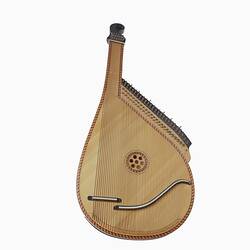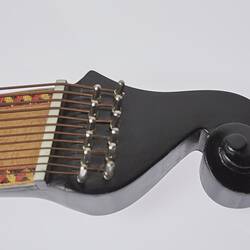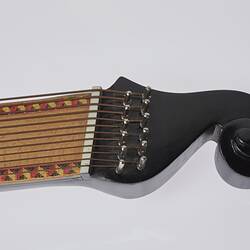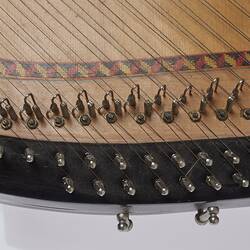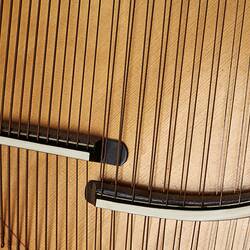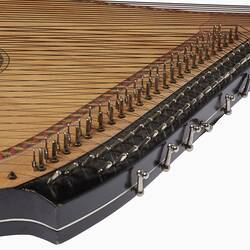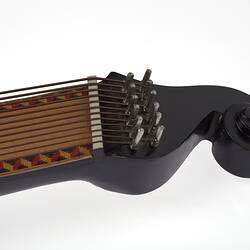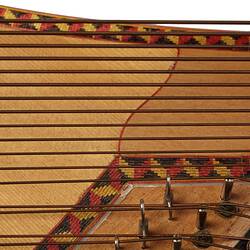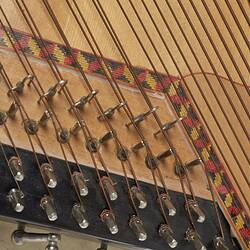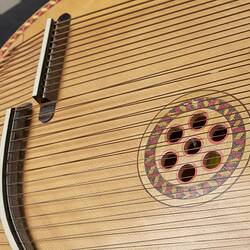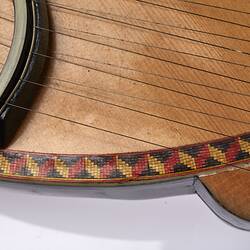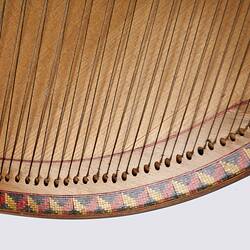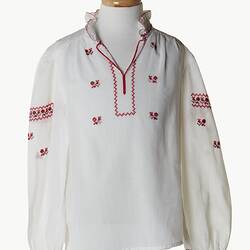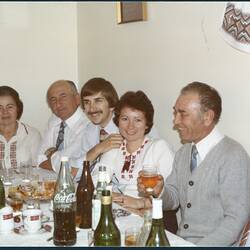Summary
Bandura purchased by Natalie Senjov-Makohon's parents Katerina and Peter Senjov from a Kyiv taxi driver when he came to Melb in 1980. During the Ukrainian winter, he worked on Soviet ships. On one of the stops in Melbourne he brought a bandura which he was selling. He could feed his family for a whole year from this sale.
The taxi driver's cultural heritage was Tartarian from Crimea but he lived and worked in Kyiv during the summer months as a taxi driver which is where Natalie's parents originally met him. So when he came to Melbourne, they purchased the bandura. The bandura was used here by Adrian Makohon to learn the bandura and play at concerts at community events in Melbourne.
This item is part of a collection of textiles, cultural objects and photographs relating to the migration and settlement experiences of Katerina Senjov, and her daughter Natalie Senjov-Makohon who inherited her mother's passion for maintaining her Ukrainian cultural heritage.
Katerina Senjov (nee Burlak) and her husband Peter migrated to Melbourne from what is now Bosnia-Herzegovnia in 1954. Despite growing up in Bosnia, the Senjov and Burlak families always culturally identified as Ukrainian and spoke Ukrainian language.
They settled first in Geelong and then in Ascot Vale, had two children Natalie and Steven, whom they encoraged to learn traditional Ukrainian culture and traditions. The Senjovs actively participated in the Ukrainian community (including choirs, dance groups and gatherings wearing traditional regional clothing usually made by Katerina or her daughter Natalie).
The mother and daughter produced, wore, used, purchased and received, a range of Ukrainian cultural items including embroidered domestic and religious textiles, Ukrainian textile design publications, Pysanky (hand-painted eggs), a Bandura (stringed musical instrument) and timber inlay artworks.
Physical Description
Timber instrument, pale brown face with black laquered timber body (sides & back) and black head stock. Yellow red and black zigzag pattern on edge of instrument. 61 strings in varied thickness. Black and white bridges and multiple metal nuts, tuning pegs and string posts. Central sound hole with 7 internal holes.
Significance
This collection provides a significant representation of traditional Ukrainian life and cultural practices subsequently transported to Australia through migration, and retained as part of the preservation, maintenance and adaptation of cultural life. In this family there was a strong and active passing down of cultural traditions, particularly down the female line.
The Museum holds a range of regional costumes, or costume components, from Sardinia, Latvia, Estonia, Poland, South Africa, Albania, Scotland, Greece, Hungary, Slovenia and Argentina; this collection relating to Ukraine further strengthens and expands the cultural representation of the collection. This material has been worn and used, is well provenanced, and has accompanying photographic documentation. This collection is also an important addition to the currently small collection relating to Ukrainian migration and settlement experiences.
The collection also includes domestic and religious Ukrainian embroidery and weaving, books documenting traditional Ukrainian designs used as references by the makers in Australia, Pysanky (painted eggs) in the tradition of many eastern European countries including Ukraine, and a Bandura (Ukrainian traditional musical instrument).
These items were all of importance in the expression of identity and place, some in the country of origin, and all in the place of re-settlement. Some of the costume pieces have played a role in the activities of community organisations in Australia; like similar associations, maintaining cultural practices and customs is increasingly challenging as subsequent generations become further distanced from the original migrant generation and through the natural process of community settlement, integration and assimilation within the context of a multiculturally diverse society.
More Information
-
Collection Names
-
Collecting Areas
Migration & Cultural Diversity, Clothing & Textiles, Home & Community, Leisure
-
Date Purchased
Natalie Senjov-Makohon, Melbourne, Victoria, Australia, 1980
-
Classification
-
Category
-
Discipline
-
Type of item
-
Object Dimensions
1050 mm (Length), 510 mm (Width), 70 mm (Depth)
-
Keywords
Ukrainian Immigration, Folk Festivals, Musical Instruments, Stringed Instruments, Cultural Traditions, Cultural Identity, Artworks, Crafts, Handcrafts

